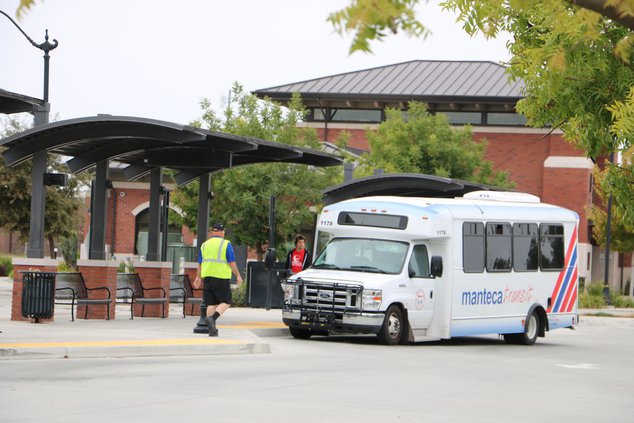Passenger train service to downtown stations in both Manteca and Ripon will start in 2023.
In doing so it will create a need for more parking spaces — upwards of 1,000 spaces based on ACE projections of 1,500 passengers boarding daily when initial service starts near the Manteca Transit Center in downtown. The transit station has just over 100 spaces.
ACE representatives have indicated a passenger platform in Manteca will be placed in such a manner that the three morning trains and three afternoon trains will not block the Main Street crossing when they are stopped to load and unload passengers.
No details have been announced regarding the precise parking need but if two thirds of those riders were not dropped off, nor take public transit, walk, carpool, or bicycle it would mean 1,000 parking spaces would be needed to avoid the use of existing parking lots and street parking all day by commuters.
The city has looked at buying additional property along Moffat Boulevard to tie it into what they own between the Manteca Veterans Hall/Moffat Community Center and the existing transit center parking lot. Also on the municipal radar in terms of possible parking is the vacant parcel where the Manteca Bean Co. once stood directly across Moffat from the transit center.
A third possibility could be land south of the tracks that the city owns such as the solid waste yard that will be relocated to the wastewater treatment plant.
A parking lot at that location would require a pedestrian bridge over the tracks or a tunnel beneath them.
The $500 million plus Valley Rail Project funded with gas tax that will extend and expand Altamont Corridor Express service as well as add Amtrak San Joaquins passenger trains from Bakersfield to Sacramento.
It will initially include three northbound ACE trains originating in Ceres traveling to Natomas north of downtown Sacramento for the morning commute and starting from Sacramento an existing ACE train that now originates in Stockton and travels to San Jose.
Altogether it will create a heavy rail service that allows commuters to access more than 2.25 million existing jobs within 2.5 miles of 10 existing stations and 16 new stations.
The plan also calls for the creation of a transfer point with a new North Lathrop station on the eastern edge of the Sharpe Depot site next door to Manteca’s city limits. At this point someone catching a train in Ceres, Modesto, Ripon or downtown Manteca could switch to trains to head into San Jose or also continue north into Sacramento. This is also where Valley Link — an effort to provide a connection to BART service that now ends in Dublin’/Pleasanton to Stockton with stops along the way at River Islands, Tracy, and Livermore — will connect with ACE service. Valley Link could be up and running by 2028.
The second phase of the ACE portion of the project is targeted to extend service south of Ceres into Merced with stops in Turlock as well as Livingston/Atwater by 2027. The Merced and San Jose stations that ACE connects are also stations for the California High Speed Rail.
Originally the ACE plan had called for double tracking through Manteca to Ceres.
In a bid to invest in infrastructure to eliminate train delays in Stockton due to at-grade crossing of the Union Pacific line that will carry ACE trains over the Santa Fe Railroad tracks, funding is being directed into extending and/or upgrading sidings and improving curves.
Between Stockton and Natomas eight sidings will be addressed as well as six curves reworked. The curves that currently accommodate top speeds of 60 mph will be re-engineered to handle 90 mph trains. That will easily accommodate ACE trains that are expected to travel at 79 mph.
The upgrades needed to extend ACE to downtown Manteca, Ripon, Modesto, and Ceres include constructing passenger platforms and parking lots as well as tracks to possibly accommodate trains parked in Ceres.
Physical station buildings such as those in Manteca, Tracy, Stockton, and San Jose are not a requirement of service. Ripon, however, is working to secure funding for a station.
Details of how the extension of Altamont Corridor Service from Ceres to Sacramento will unfold are contained in an environmental impact report for the Valley Rail Project released by the San Joaquin Rail Commission that is being publically vetted through May 15.
A copy of the Draft Environmental Impact Report (including all appendices) can be found on the project website at www.acerail.com or www.sjjpa.com.
To contact Dennis Wyatt, email dwyatt@mantecabulletin.com





